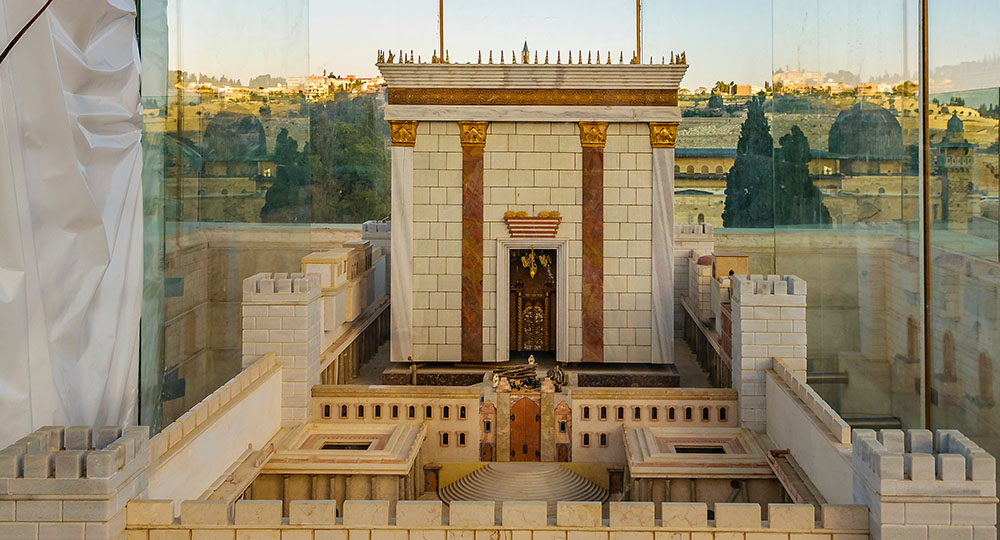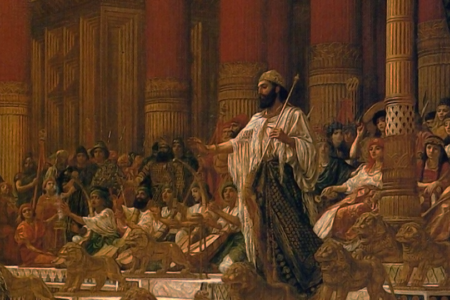Solomon’s Temple
King Solomon’s reign has been called Israel’s Golden Age. Under him, the Israelites possessed almost all of the land God promised them (1 Ki. 4:21, 24).1 They lived in complete security, peace, and rest; and Solomon built the magnificent Temple of the Lord on Mount Moriah in Jerusalem, “where the LORD had appeared to his father David” (2 Chr. 3:1).
Solomon knew the serenity of his kingdom was God’s doing: “Now the LORD my God has given me rest on every side; there is neither adversary nor evil occurrence” (1 Ki. 5:4). Nevertheless, he put formidable safeguards in place. He erected massive fortifications and walls and acquired thousands of chariots and horses (the equivalent of today’s armored fighting vehicles), which he stationed in strategic locations throughout Israel, along with supplies (9:15–19; 2 Chr. 8:3–6; 9:25).
But the greatest honor God gave Solomon was the privilege of building Him a house in Jerusalem (1 Chr. 22:10). David had wanted desperately to build the Temple. But David was a man of war who had shed much blood (28:3). Although God gave David the blueprint and David provided most of the building materials (28:11–19; 29:19), God chose Solomon to build the structure because Solomon’s reign would see peace.
Over seven years, Solomon built a magnificent stone house for God (1 Ki. 6:7, 38). The Temple had three parts: the porch; nave, or Holy Place; and holy of holies. Together, they measured approximately 120 feet long and 34 feet wide. The porch was 207 feet high, while the rest of the building was 52 feet high.2
Two enormous, beautifully decorated bronze pillars stood guard at the entryway (7:15–22). The building’s interior had cedarwood walls, cypress wood floors and doors, and olive wood doors (6:15, 31, 34). All the wood was overlaid with pure gold and engraved with images of cherubim, palm trees, and open flowers (vv. 21–22, 29, 32, 35).
Amazingly, the Temple “was built with stone finished at the quarry, so that no hammer or chisel or any iron tool was heard in the temple while it was being built” (v. 7). It’s difficult to imagine such an accomplishment even today.
In the innermost sanctuary (holy of holies), two 17-foothigh olive wood cherubim, overlaid with gold and with wings outstretched, overshadowed the gilded Ark that contained the two stone tablets of the Mosaic Covenant (vv. 23–28; 8:6–7, 9).
But the Temple’s stunning splendor was not what distinguished or brought honor to Solomon and his kingdom. What distinguished Israel—what no other nation to this day can claim—was the presence of the living God in its midst.
After Solomon dedicated the Temple to the Lord, offering prayers and sacrifices, “fire came down from heaven and consumed the burnt offering and the sacrifices; and the glory of the LORD filled the temple” (2 Chr. 7:1). God was dwelling among His beloved people Israel. In response, the Israelites “bowed their faces to the ground on the pavement, and worshiped and praised the LORD, saying: ‘For He is good, for His mercy endures forever’” (v. 3).
Unfortunately, the Israelites did not remain loyal to God; and in 586 BC, approximately 380 years after its completion, Solomon’s Temple was burned to the ground by the Babylonians; and the Jewish people were exiled to Babylon.
ENDNOTES
-
- See Numbers 34:1–15. Solomon ruled from the Euphrates River to the border of Egypt (probably Wadi al-Arish). He did not possess or rule Phoenicia (Lebanon), which was part of the promised territory; but he did have an alliance with the Phoenicians (1 Ki. 5:1–12).
- See 1 Kings 6:2–3 and 2 Chronicles 3:3–4. Measurement is based on the royal cubit of 52.5 centimeters. See Randall Price with H. Wayne House, Zondervan Handbook of Biblical Archaeology (Grand Rapids, MI: Zondervan, 2017), 130.









Like the temple, what makes us the believers special is God residing in us, not anything of our own. Just like Israel we fall away and our God of Love continues His work and guides is back.